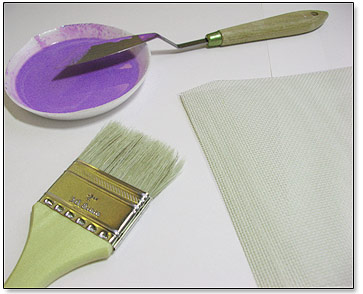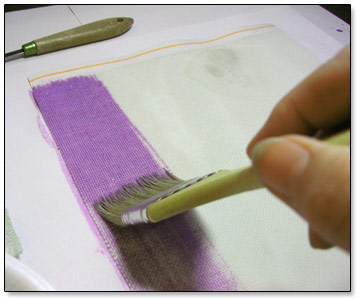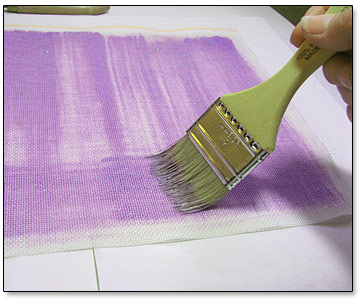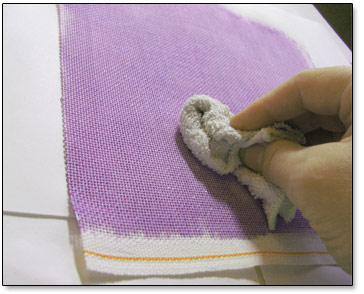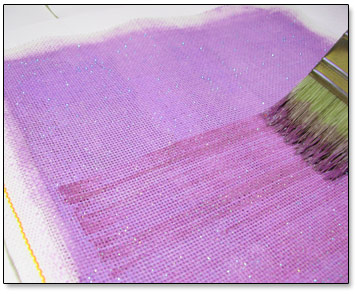With your paint mixed to the consistency of whole milk. It is now time to apply it to the canvas.
Refer to “Painting Lavender Glitter Canvas – Part 1” if you missed it.
Lesson #2 Application to the canvas
First, lay your plain white canvas and spray it with a fine mist of water. Turn it over and spray the back side too.
Spray just enough to feel the canvas go limp. This will help break the sizing and allow the paint to penetrate between the fibers of the canvas threads a bit better.
– – – – – – – – – – – – – – – – – – – – – – – – – – – – – – – – – – – – – – – – – – – – – – – – – – – – – – – –
Note 3: Painting the canvas is just a “coating”, the fibers of the canvas threads are not going to take up the paint like in a dyeing process. This sort of paint wash is very permanent, but not completely penetrating. If you plan to do pulled thread stitches, there will be tiny white dots that reveal themselves when the canvas threads are distorted.
– – – – – – – – – – – – – – – – – – – – – – – – – – – – – – – – – – – – – – – – – – – – – – – – – – – – – – – –
Use a wide, stiff bristle painters brush to paint the wash on the canvas. Load the brush half way with paint, and allow the excess to drip back into the container by dragging the brush across the edge.
– – – – – – – – – – – – – – – – – – – – – – – – – – – – – – – – – – – – – – – – – – – – – – – – – – – – – – – –
Apply in strokes that are parallel to each other, and overlapping slightly. Rotate your canvas, and apply a layer of cross strokes. Repeat this one more time and the canvas should be close to covered.
If there are any areas that look a bit thin, apply small amounts of paint and “scrub” the canvas with the brush in an upright position. This will also help dislodge some of the paint tension that may develop in the canvas holes.
Once the surface of the canvas looks even, turn the canvas over to the backside and blot with the terry cloth towel to remove the final excess paint.
Hold the canvas up and check for filled holes. There should be very few, but if there are some, try blowing through the canvas to break them.
– – – – – – – – – – – – – – – – – – – – – – – – – – – – – – – – – – – – – – – – – – – – – – – – – – – – – – – –
Side Note: When I mixed the paint for this sample canvas, I did not mix enough. I decided to add a second set of paint layers to strengthen the color. Notice the application of a darker color value below. Just for the heck of it, I left some of the striations on the finished canvas.
– – – – – – – – – – – – – – – – – – – – – – – – – – – – – – – – – – – – – – – – – – – – – – – – – – – – – – – –
Final Steps:
Let the canvas dry. Iron with a dedicated craft iron (not your good one) on the cotton setting. Iron both the back and the front of the painted canvas allowing for a 3-second hold before moving to the next spot.
Congratulations – Custom colored canvas awaits your imagination!
